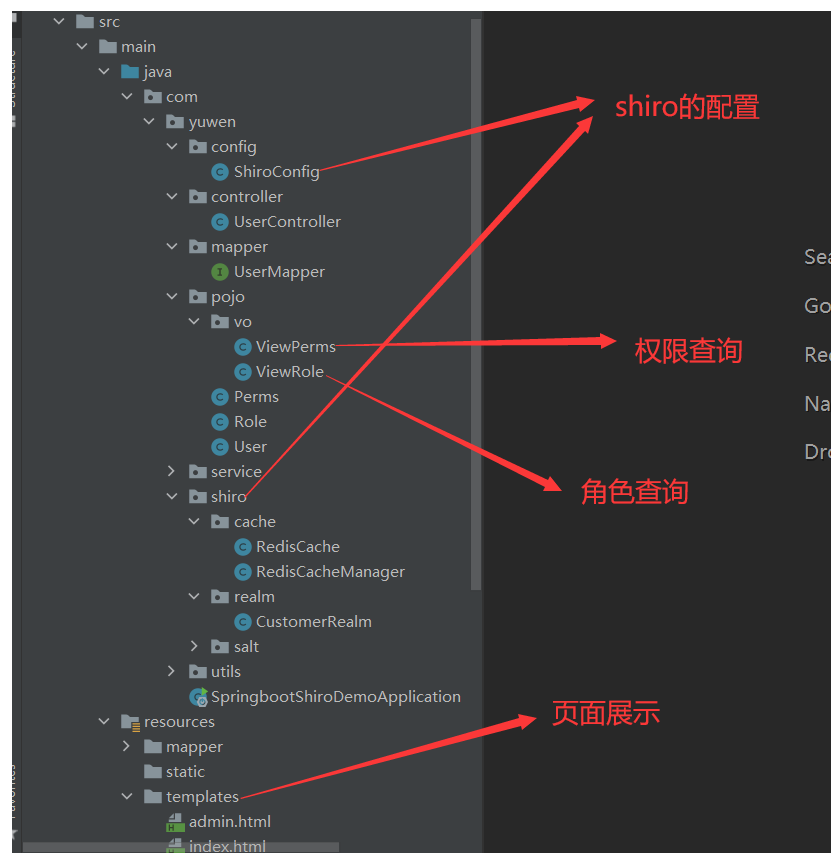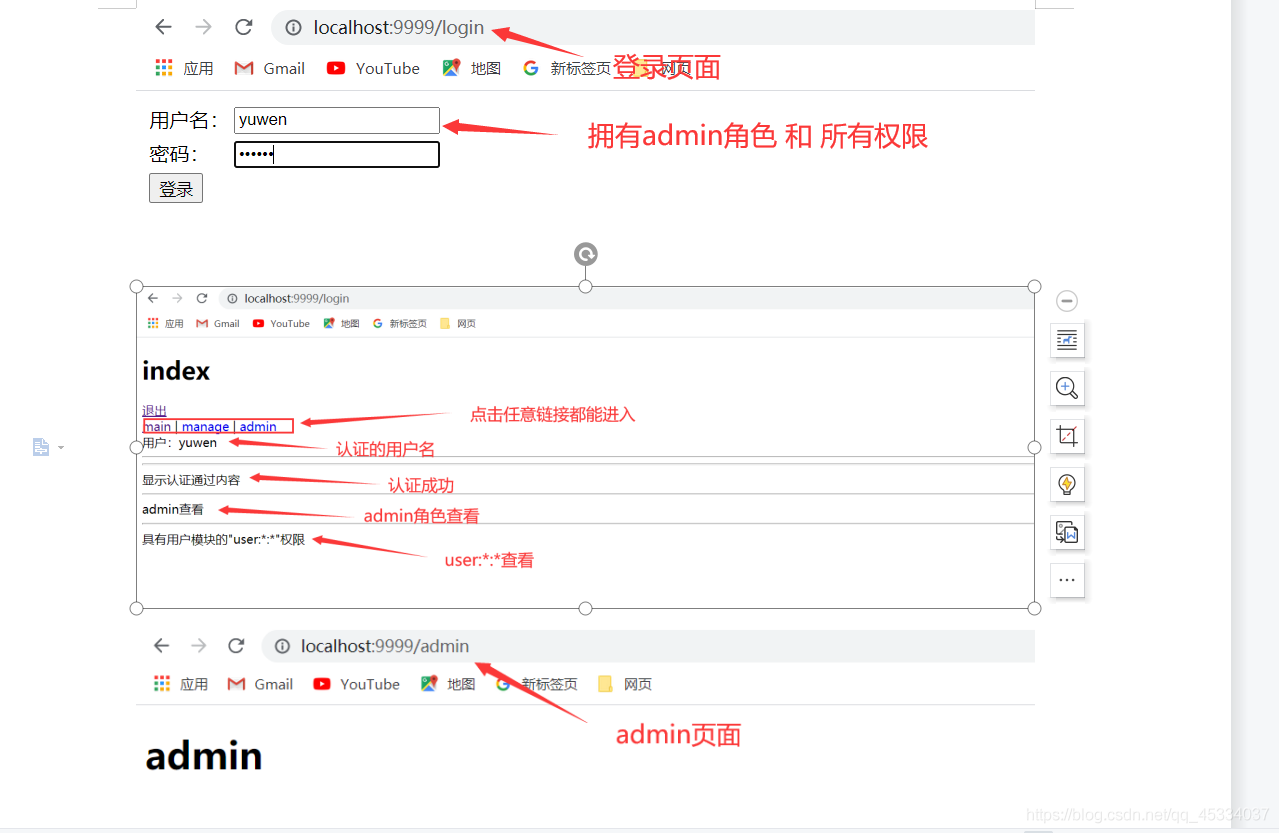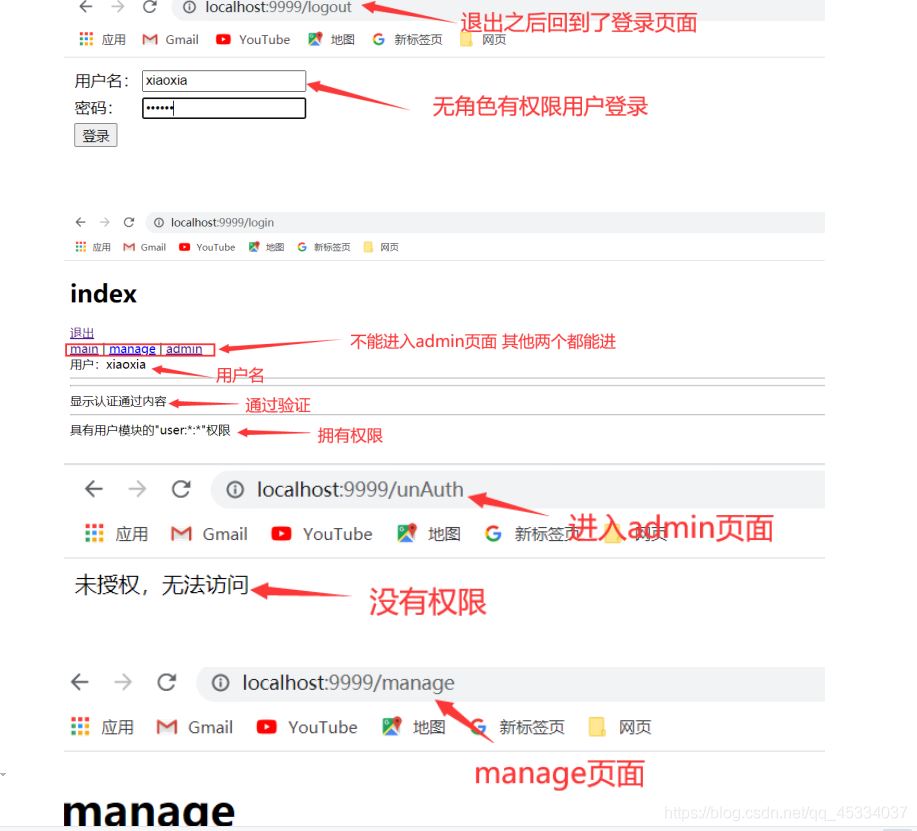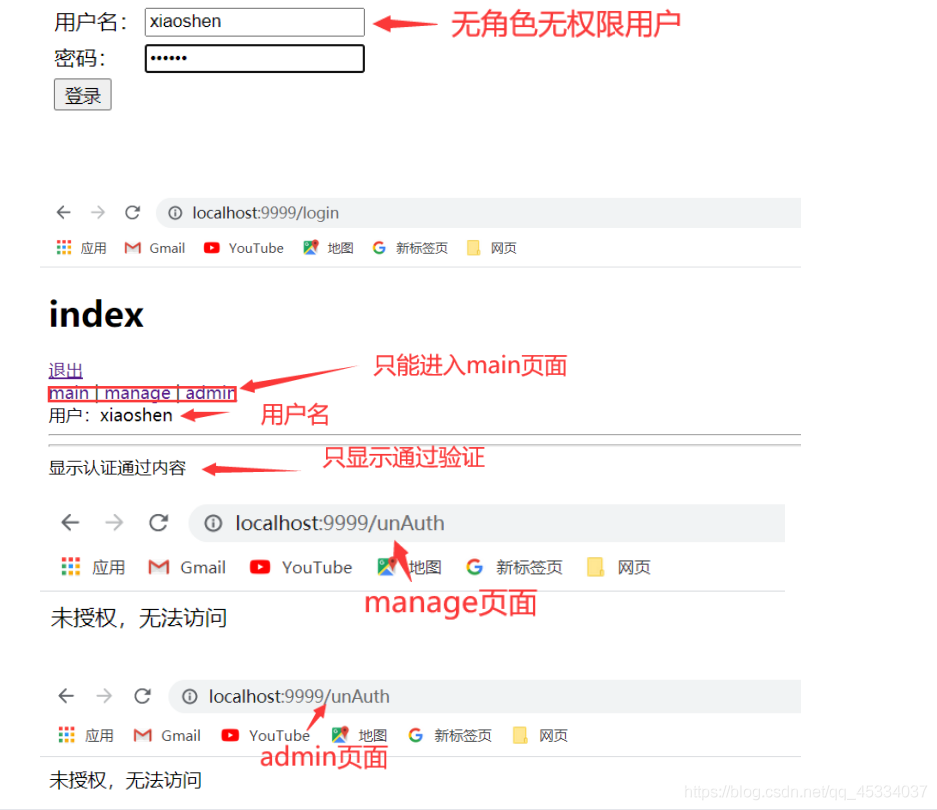How SpringBoot integrates Shiro to implement permission control
1. SpringBoot integrates Shiro
Apache Shiro is a powerful and easy-to-use Java security framework that performs authentication, authorization, password and session management.
1.1. Introduction to shiro
Shiro has core components, namely Subject, SecurityManager and Realms
Subject: equivalent to the "user of the current operation" "This user is not necessarily a specific person, but an abstract concept, indicating anything that interacts with the current program, such as crawlers, scripts, etc. All Subjects are bound to the SecurityManager, and all interactions with the Subject will be delegated to the SecurityManager; the Subject can be considered as a facade; the SecurityManager is the actual executor.
SecurityManager: This is the core of the shiro framework. All security-related operations will interact with it. It manages all Subjects.
Realms: Acts as a "bridge" between Shiro and application security data. When performing authentication (login) and authorization (access control) verification on users, SecurityManager needs to obtain the corresponding information from Realm. Compare the user's identity to determine whether the user's identity is legitimate; it is also necessary to obtain the user's corresponding role/authority from Realm to verify whether the user can perform operations.
1.2. Specific implementation of the code
1.2.1. Maven configuration
<!--shiro-->
<dependency>
<groupId>org.apache.shiro</groupId>
<artifactId>shiro-spring-boot-starter</artifactId>
<version>1.7.1</version>
</dependency>
<!--shiro整合thymeleaf-->
<dependency>
<groupId>com.github.theborakompanioni</groupId>
<artifactId>thymeleaf-extras-shiro</artifactId>
<version>2.0.0</version>
</dependency>
<!--shiro缓存-->
<dependency>
<groupId>org.apache.shiro</groupId>
<artifactId>shiro-ehcache</artifactId>
<version>1.7.1</version>
</dependency>shiro is used with jsp by default, and here is shiro integrates thymeleaf All jar packages that need to be imported into shiro to integrate thymeleaf
1.2.2. Classes that need to be implemented for integration
Generally speaking, integration only needs to complete two classes Just implement it
One is ShiroConfig and the other is CustomerRealm
If you need to add shiro cache and it is not the built-in cache but the redis cache, you still need Write the other two classes
One is RedisCache and the other is RedisCacheManager

package com.yuwen.config;
import at.pollux.thymeleaf.shiro.dialect.ShiroDialect;
import com.yuwen.shiro.cache.RedisCacheManager;
import com.yuwen.shiro.realm.CustomerRealm;
import org.apache.shiro.authc.credential.HashedCredentialsMatcher;
import org.apache.shiro.realm.Realm;
import org.apache.shiro.spring.web.ShiroFilterFactoryBean;
import org.apache.shiro.web.mgt.DefaultWebSecurityManager;
import org.springframework.beans.factory.annotation.Qualifier;
import org.springframework.context.annotation.Bean;
import org.springframework.context.annotation.Configuration;
import java.util.HashMap;
import java.util.Map;
@Configuration
public class ShiroConfig {
//让页面shiro标签生效
@Bean
public ShiroDialect shiroDialect(){
return new ShiroDialect();
}
//1、创建shiroFilter 负责拦截所有请求
@Bean
public ShiroFilterFactoryBean shiroFilterFactoryBean(DefaultWebSecurityManager defaultWebSecurityManager){
ShiroFilterFactoryBean factoryBean = new ShiroFilterFactoryBean();
//给filter设置安全管理
factoryBean.setSecurityManager(defaultWebSecurityManager);
//配置系统的受限资源
//配置系统公共资源 全部都能访问的设置anon
Map<String,String> map = new HashMap<>();
map.put("/main","authc");//请求这个资源需要认证和授权 authc表示需要认证后才能访问
map.put("/admin","roles[admin]"); //表示admin角色才能访问 roles[]表示需要什么角色才能访问
map.put("/manage","perms[user:*:*]"); //表示需要user:*:*权限才能访问 perms[]表示需要什么权限才能访问
//访问需要认证的页面如果未登录会跳转到/login路由进行登陆
factoryBean.setLoginUrl("/login");
//访问未授权页面会自动跳转到/unAuth路由
factoryBean.setUnauthorizedUrl("/unAuth");
factoryBean.setFilterChainDefinitionMap(map);
return factoryBean;
}
//2、创建安全管理器
@Bean
public DefaultWebSecurityManager defaultWebSecurityManager(@Qualifier("getRealm") Realm realm){
DefaultWebSecurityManager securityManager = new DefaultWebSecurityManager();
//给安全管理器设置
securityManager.setRealm(realm);
return securityManager;
}
//3、创建自定义的realm
@Bean
public Realm getRealm(){
CustomerRealm customerRealm = new CustomerRealm();
//修改凭证校验匹配器
HashedCredentialsMatcher credentialsMatcher = new HashedCredentialsMatcher();
//设置加密算法为md5
credentialsMatcher.setHashAlgorithmName("MD5");
//设置散列次数
credentialsMatcher.setHashIterations(1024);
customerRealm.setCredentialsMatcher(credentialsMatcher);
return customerRealm;
}
}package com.yuwen.shiro.realm;
import com.yuwen.pojo.User;
import com.yuwen.pojo.vo.ViewPerms;
import com.yuwen.pojo.vo.ViewRole;
import com.yuwen.service.UserService;
import com.yuwen.shiro.salt.MyByteSource;
import org.apache.shiro.authc.AuthenticationException;
import org.apache.shiro.authc.AuthenticationInfo;
import org.apache.shiro.authc.AuthenticationToken;
import org.apache.shiro.authc.SimpleAuthenticationInfo;
import org.apache.shiro.authz.AuthorizationInfo;
import org.apache.shiro.authz.SimpleAuthorizationInfo;
import org.apache.shiro.realm.AuthorizingRealm;
import org.apache.shiro.subject.PrincipalCollection;
import org.apache.shiro.util.CollectionUtils;
import org.springframework.util.ObjectUtils;
import javax.annotation.Resource;
import java.util.List;
//自定义realm
public class CustomerRealm extends AuthorizingRealm {
@Resource
private UserService userService;
//授权
@Override
protected AuthorizationInfo doGetAuthorizationInfo(PrincipalCollection principalCollection) {
//获取身份信息
String primaryPrincipal = (String)principalCollection.getPrimaryPrincipal();
//根据主身份信息获取角色 和 权限信息
List<ViewRole> roles = userService.findRolesByUsername(primaryPrincipal);
if (!CollectionUtils.isEmpty(roles)){
SimpleAuthorizationInfo simpleAuthorizationInfo = new SimpleAuthorizationInfo();
roles.forEach(viewRole -> {
simpleAuthorizationInfo.addRole(viewRole.getName());
//权限信息
List<ViewPerms> perms = userService.findPermsByRoleId(viewRole.getName());
if (!CollectionUtils.isEmpty(perms)){
perms.forEach(viewPerms -> {
simpleAuthorizationInfo.addStringPermission(viewPerms.getPName());
});
}
});
return simpleAuthorizationInfo;
}
return null;
}
//认证
@Override
protected AuthenticationInfo doGetAuthenticationInfo(AuthenticationToken authenticationToken) throws AuthenticationException {
//获取登入的身份信息
String principal = (String) authenticationToken.getPrincipal();
User user = userService.findByUsername(principal);
if (!ObjectUtils.isEmpty(user)){
//ByteSource.Util.bytes(user.getSalt()) 通过这个工具将盐传入
//如果身份认证验证成功,返回一个AuthenticationInfo实现;
return new SimpleAuthenticationInfo(user.getUsername(),user.getPassword(),new MyByteSource(user.getSalt()),this.getName());
}
return null;
}
}@PostMapping("/login")
public String login(String username,String password){
//获取主体对象
Subject subject = SecurityUtils.getSubject();
try {
//自动调用CustomerRealm 类中的身份验证方法
subject.login(new UsernamePasswordToken(username,password));
return "index";
}catch (UnknownAccountException e){ //接收异常并处理
e.printStackTrace();
model.addAttribute("msg","用户名有误,请重新登录");
}catch (IncorrectCredentialsException e){//接收异常并处理
e.printStackTrace();
model.addAttribute("msg","密码有误,请重新登录");
}
return "login";
} @Bean
public Realm getRealm(){
CustomerRealm customerRealm = new CustomerRealm();
//开启缓存管理
customerRealm.setCacheManager(new EhCacheManager());
//开启全局缓存
customerRealm.setCachingEnabled(true);
//开启认证缓存
customerRealm.setAuthenticationCachingEnabled(true);
customerRealm.setAuthenticationCacheName("authenticationCache");
//开启权限缓存
customerRealm.setAuthorizationCachingEnabled(true);
customerRealm.setAuthorizationCacheName("authorizationCache");
return customerRealm;
}<!DOCTYPE html>
<html xmlns="http://www.w3.org/1999/xhtml" xmlns:th="http://www.thymeleaf.org"
xmlns:shiro="http://www.pollix.at/thymeleaf/shiro">
<head>
<meta charset="UTF-8">
<title>首页</title>
<link rel="shortcut icon" href="#">
</head>
<body>
<h1 id="index">index</h1>
<a href="/logout">退出</a>
<div>
<a href="/main">main</a> | <a href="/manage">manage</a> | <a href="/admin">admin</a>
</div>
<!--获取认证信息-->
用户:<span shiro:principal=""></span><hr>
<!--认证处理-->
<span shiro:authenticated=""><hr>
显示认证通过内容
</span>
<span shiro:notAuthenticated=""><hr>
没有认证时 显示
</span>
<!--授权角色-->
<span shiro:hasRole="admin"><hr>
admin角色 显示
</span>
<span shiro:hasPermission="user:*:*"><hr>
具有用户模块的"user:*:*"权限 显示
</span>
</body>
</html>




The above is the detailed content of How SpringBoot integrates Shiro to implement permission control. For more information, please follow other related articles on the PHP Chinese website!

Hot AI Tools

Undresser.AI Undress
AI-powered app for creating realistic nude photos

AI Clothes Remover
Online AI tool for removing clothes from photos.

Undress AI Tool
Undress images for free

Clothoff.io
AI clothes remover

AI Hentai Generator
Generate AI Hentai for free.

Hot Article

Hot Tools

Notepad++7.3.1
Easy-to-use and free code editor

SublimeText3 Chinese version
Chinese version, very easy to use

Zend Studio 13.0.1
Powerful PHP integrated development environment

Dreamweaver CS6
Visual web development tools

SublimeText3 Mac version
God-level code editing software (SublimeText3)

Hot Topics
 1375
1375
 52
52
 How Springboot integrates Jasypt to implement configuration file encryption
Jun 01, 2023 am 08:55 AM
How Springboot integrates Jasypt to implement configuration file encryption
Jun 01, 2023 am 08:55 AM
Introduction to Jasypt Jasypt is a java library that allows a developer to add basic encryption functionality to his/her project with minimal effort and does not require a deep understanding of how encryption works. High security for one-way and two-way encryption. , standards-based encryption technology. Encrypt passwords, text, numbers, binaries... Suitable for integration into Spring-based applications, open API, for use with any JCE provider... Add the following dependency: com.github.ulisesbocchiojasypt-spring-boot-starter2. 1.1Jasypt benefits protect our system security. Even if the code is leaked, the data source can be guaranteed.
 How SpringBoot integrates Redisson to implement delay queue
May 30, 2023 pm 02:40 PM
How SpringBoot integrates Redisson to implement delay queue
May 30, 2023 pm 02:40 PM
Usage scenario 1. The order was placed successfully but the payment was not made within 30 minutes. The payment timed out and the order was automatically canceled. 2. The order was signed and no evaluation was conducted for 7 days after signing. If the order times out and is not evaluated, the system defaults to a positive rating. 3. The order is placed successfully. If the merchant does not receive the order for 5 minutes, the order is cancelled. 4. The delivery times out, and push SMS reminder... For scenarios with long delays and low real-time performance, we can Use task scheduling to perform regular polling processing. For example: xxl-job Today we will pick
 How to use Redis to implement distributed locks in SpringBoot
Jun 03, 2023 am 08:16 AM
How to use Redis to implement distributed locks in SpringBoot
Jun 03, 2023 am 08:16 AM
1. Redis implements distributed lock principle and why distributed locks are needed. Before talking about distributed locks, it is necessary to explain why distributed locks are needed. The opposite of distributed locks is stand-alone locks. When we write multi-threaded programs, we avoid data problems caused by operating a shared variable at the same time. We usually use a lock to mutually exclude the shared variables to ensure the correctness of the shared variables. Its scope of use is in the same process. If there are multiple processes that need to operate a shared resource at the same time, how can they be mutually exclusive? Today's business applications are usually microservice architecture, which also means that one application will deploy multiple processes. If multiple processes need to modify the same row of records in MySQL, in order to avoid dirty data caused by out-of-order operations, distribution needs to be introduced at this time. The style is locked. Want to achieve points
 How to solve the problem that springboot cannot access the file after reading it into a jar package
Jun 03, 2023 pm 04:38 PM
How to solve the problem that springboot cannot access the file after reading it into a jar package
Jun 03, 2023 pm 04:38 PM
Springboot reads the file, but cannot access the latest development after packaging it into a jar package. There is a situation where springboot cannot read the file after packaging it into a jar package. The reason is that after packaging, the virtual path of the file is invalid and can only be accessed through the stream. Read. The file is under resources publicvoidtest(){Listnames=newArrayList();InputStreamReaderread=null;try{ClassPathResourceresource=newClassPathResource("name.txt");Input
 How to implement Springboot+Mybatis-plus without using SQL statements to add multiple tables
Jun 02, 2023 am 11:07 AM
How to implement Springboot+Mybatis-plus without using SQL statements to add multiple tables
Jun 02, 2023 am 11:07 AM
When Springboot+Mybatis-plus does not use SQL statements to perform multi-table adding operations, the problems I encountered are decomposed by simulating thinking in the test environment: Create a BrandDTO object with parameters to simulate passing parameters to the background. We all know that it is extremely difficult to perform multi-table operations in Mybatis-plus. If you do not use tools such as Mybatis-plus-join, you can only configure the corresponding Mapper.xml file and configure The smelly and long ResultMap, and then write the corresponding sql statement. Although this method seems cumbersome, it is highly flexible and allows us to
 Comparison and difference analysis between SpringBoot and SpringMVC
Dec 29, 2023 am 11:02 AM
Comparison and difference analysis between SpringBoot and SpringMVC
Dec 29, 2023 am 11:02 AM
SpringBoot and SpringMVC are both commonly used frameworks in Java development, but there are some obvious differences between them. This article will explore the features and uses of these two frameworks and compare their differences. First, let's learn about SpringBoot. SpringBoot was developed by the Pivotal team to simplify the creation and deployment of applications based on the Spring framework. It provides a fast, lightweight way to build stand-alone, executable
 How SpringBoot customizes Redis to implement cache serialization
Jun 03, 2023 am 11:32 AM
How SpringBoot customizes Redis to implement cache serialization
Jun 03, 2023 am 11:32 AM
1. Customize RedisTemplate1.1, RedisAPI default serialization mechanism. The API-based Redis cache implementation uses the RedisTemplate template for data caching operations. Here, open the RedisTemplate class and view the source code information of the class. publicclassRedisTemplateextendsRedisAccessorimplementsRedisOperations, BeanClassLoaderAware{//Declare key, Various serialization methods of value, the initial value is empty @NullableprivateRedisSe
 How to get the value in application.yml in springboot
Jun 03, 2023 pm 06:43 PM
How to get the value in application.yml in springboot
Jun 03, 2023 pm 06:43 PM
In projects, some configuration information is often needed. This information may have different configurations in the test environment and the production environment, and may need to be modified later based on actual business conditions. We cannot hard-code these configurations in the code. It is best to write them in the configuration file. For example, you can write this information in the application.yml file. So, how to get or use this address in the code? There are 2 methods. Method 1: We can get the value corresponding to the key in the configuration file (application.yml) through the ${key} annotated with @Value. This method is suitable for situations where there are relatively few microservices. Method 2: In actual projects, When business is complicated, logic




